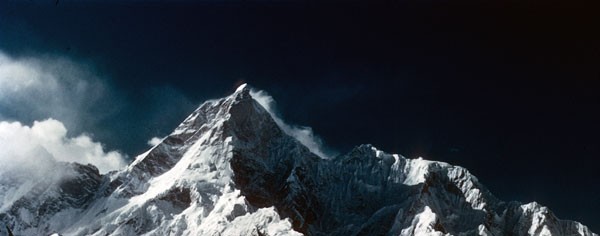Los Alamos Mountaineers
You are here
The LAM Climbing School
For many decades, the Los Alamos Mountaineers have held an annual 5 or 6 week long climbing school each April and May. This is an ideal way for people with an interest in mountaineering or climbing to safely acquire some basic rope handling and climbing skills. It is also a great way for beginners to meet other club members and for the club itself to acquire eager new members.
Tom Newton, who was the Mountaineers first president in 1952, recalls that the climbing school began during the late 1950's and that it was originally held in the Back Rocks behind the North Community in Los Alamos. Don Monk and Kermit Ross were the first to use this area for training new climbers. The rock there is rhyolite and not nearly as good as the basalt of White Rock Canyon. Bob Cowan remembers that George Bell and John Marshall were among the instructors in 1967 when he joined. The school still consists of a series of evening lectures and Saturday outdoor sessions. The outdoor classes cover basic free climbing techniques, as well as rope handling techniques such as belaying, rappelling, prussiking, tying off the leader, and setting anchors.
Fig. 1. Two climbers during the April 1967 climbing school,
held at the Back Rocks in Los Alamos (Bob Cowan photo).
In the late 1960's the climbing school began to transition from the Back Rocks to several of the newly-discovered White Rock climbing areas, primarily Potrillo Cliffs and the "Y." A major exciting and stressful moment for most students is catching "Ludwig," a heavy weight that simulates the shock and pain of catching a leader fall. John Ramsay believes that Gene Tate invented this exercise to train new climbers in how to belay and arrest a falling leader. For about 20 years now, Jim Straight has taken the lead in rigging and running this exercise, with the gratitude of his fellow instructors and the apprehension of his student victims!
Fig. 2. Jim Straight rigs the Ludwig leader fall
exercise at the "Y" during the climbing school
(Danny Gallant photo, April 2005 or 2006).
Fig. 3. Ruth Kirkpatrick smiles while catching Ludwig during the April 2007
climbing school at the "Y." Chris Horley (back to camera) provides close
instructor support, while Dave Dogruel (far upper right) enjoys operating
the release mechanism (Jason Halladay photo).
Another stressful moment in the school is the first rappel from the top of the cliff. Mario Schillaci recalls that he and Ray Nix were in the 1968 climbing school, and their instructor, Ernie Anderson, was encouraging all the students to commit fully to the rappel by really leaning back at the start. Ray Nix was determined to do this right, and leaned back very far. Sure enough, he flipped over backwards, and ended up hanging head down against the cliff! This event happened to a new student every now and then over the years. But this rappel exercise was always conducted with a separate belay, so no harm was done.
Through the 1980's, the climbing school included a day of snow climbing instruction. This was usually held at Pajarito Ski Area, Santa Fe Ski Basin, or Lake Peak, depending on snow conditions and on whether the ski areas were open or closed in mid-April. The snow climbing day included instruction from Ken Ewing on analyzing snow packs for avalanche danger. Climbers practiced roped travel on snow, glissading, ice axe belay, and ice-axe self-arrest techniques. When the snow day was held at Raven's Ridge, the participants could climb the west face of Lake Peak, getting good practice in being part of a 3-person rope team on a moderately steep snow slope. With decreased interest among the Mountaineers in snow and ice climbing, this activity was discontinued around 1990. However, instruction in some aspects of snow travel and avalanche awareness is still available through Colorado search and rescue organizations.
Fig. 4. Ken Ewing demonstrates ice axe techniques during
the April 1968 climbing school (Bob Cowan photo)
Graduation climbs for the climbing school used to be held at the Brazos Cliffs or in the Sandias, with 3-person parties doing long ascents of the Shield or the Knife Edge. After a long and tedious climbing experience in the Sandias in 1973, the Mountaineers moved the graduation climb to the El Rito cliff, which the Mountaineers had just learned about from Santa Fe rock climbers. This small climbing area provides excellent 2- and 3-pitch crack and face climbs at a moderate level but with good practice in belay ledges, exposure, and multi-pitch rope handling techniques.
Theme by Danetsoft and Danang Probo Sayekti inspired by Maksimer
